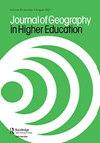Navigating STEMification for critical geography educators: finding leverage in classroom and institutional pedagogies
IF 1.8
4区 教育学
Q2 EDUCATION & EDUCATIONAL RESEARCH
引用次数: 0
Abstract
ABSTRACTThis paper grapples with the challenges posed to critical geography educators by STEMification, or the enshrinement of market-oriented forms of science and technology education as the normative ideal for education in general. In both reactionary and progressive contexts, STEMification decontextualizes scientific and technological activity and deepens existing hierarchies of knowledge based on quantification, perceived scientific rigour, commercialisation, and employability. Critical geographical knowledges often incur misrecognition, dismissal, and in some cases, outright prohibition under such conditions. Offering strategies for navigating and contesting STEMification, this paper draws on collective auto-methods, analysing narrative vignettes from our pedagogical practices as critical geography educators. We offer the notion of seeking leverage in the face of STEMification: protecting ourselves and seeking traction within our institutions by translating our goals into familiar or sanctioned forms, while using those forms to alternative ends. To that end, we highlight seven pedagogical strategies: (1) meeting students where they are, (2) using applied examples, (3) grappling with the limits of problem-based learning, (4) disalienating students from assessment, (5) integrating critique with alternatives, (6) anticipating both resistance to and desire for critical content from students and colleagues, and (7) recognising the limits of institutional environments.KEYWORDS: StemificationSTEMauto-methodsneoliberalismcritical geography pedagogy Disclosure statementNo potential conflict of interest was reported by the author(s).Notes1. We thank the critical planning scholar Prasad Khanolkar of the Indian Institute of Technology Guwahati for his insightful participation in that session and subsequent conversations, which have inestimably enhanced this paper.2. Disturbingly, recent developments in problem-based learning tie the development of technical solutions to their monetisation, often in a start-up, venture-capital-backed environment (Nellis, Citation2017).为批判性地理教育者导航STEMification:在课堂和机构教学法中寻找杠杆作用
摘要本文探讨了科学技术教育市场化,即把科学技术教育的市场化形式奉为一般教育的规范理想,给批判性地理教育工作者带来的挑战。在反动和进步的背景下,STEMification都使科学和技术活动脱离了背景,并加深了基于量化、感知科学严谨性、商业化和就业能力的现有知识等级。在这种情况下,重要的地理知识往往会引起误解、解雇,在某些情况下,甚至会被彻底禁止。本文提供了导航和竞争STEMification的策略,借鉴了集体自动方法,分析了我们作为批判性地理教育者的教学实践中的叙事小片段。我们提出了在STEMification面前寻求杠杆的概念:通过将我们的目标转化为熟悉或认可的形式来保护我们自己,并在我们的机构中寻求牵引力,同时利用这些形式实现其他目的。为此,我们强调了七种教学策略:(1)满足学生的需求,(2)使用应用实例,(3)解决基于问题的学习的局限性,(4)使学生远离评估,(5)将批评与替代方案相结合,(6)预测学生和同事对批判性内容的抵制和渴望,以及(7)认识到制度环境的局限性。关键词:stemification stem - auto-method自由主义批判地理学教学法披露声明作者未报告潜在的利益冲突。我们感谢印度古瓦哈蒂理工学院的关键规划学者Prasad Khanolkar在该会议和随后的对话中富有洞察力的参与,这对本文有不可估量的促进作用。令人不安的是,基于问题的学习的最新发展将技术解决方案的发展与其货币化联系在一起,通常是在初创企业、风险资本支持的环境中(Nellis, Citation2017)。
本文章由计算机程序翻译,如有差异,请以英文原文为准。
求助全文
约1分钟内获得全文
求助全文
来源期刊

Journal of Geography in Higher Education
Multiple-
CiteScore
5.80
自引率
9.50%
发文量
29
期刊介绍:
The Journal of Geography in Higher Education ( JGHE) was founded upon the conviction that the development of learning and teaching was vitally important to higher education. It is committed to promote, enhance and share geography learning and teaching in all institutions of higher education throughout the world, and provides a forum for geographers and others, regardless of their specialisms, to discuss common educational interests, to present the results of educational research, and to advocate new ideas.
 求助内容:
求助内容: 应助结果提醒方式:
应助结果提醒方式:


